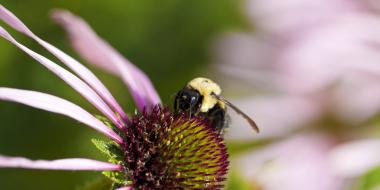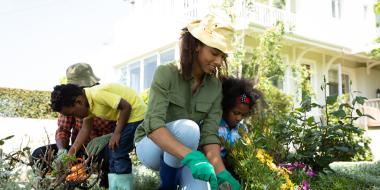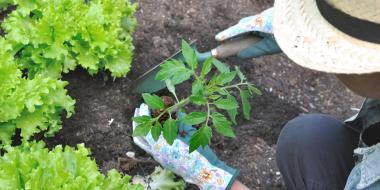Listen up and I'll tell you a story about the romance of worms. Sure, they make your soil fertile, but did you know that they're also a great way to meet attractive people? Stay tuned to find out how both are true stories!
First, the cute-meet
I was new to the city of Edmonton, at a community meeting where there was only one other person not 15 years my senior. I overheard him say something about his worms. I rushed over, so excited that I forgot to introduce myself. “You have worms? Can I have some?!?” I exclaimed. I immediately turned red and thought, "Now there’s an original pick up line"… (we did end up seeing each other for a brief time, funnily enough).
The point of this story is that YES, worms can be that exciting! Maybe not to the uninitiated, but once you get to know them it’s hard not to be won over by these wiggling wonders.
Meet the Red Wiggler
Now I’m not just talking about your regular garden earthworm. I’m referring to the red wiggler worms (Eisenia fetida) that are used for indoor composting, also known as vermicomposting. There is a difference! You can’t just use any old worm for composting. You require worms that eat decomposing food—most of the worms you see outside on the pavement after a rain actually eat dirt.
Fun worm facts
- Worms have 5 hearts but no eyes or ears
- There are 4400 species of worms in the world
- In the time of the Pharaohs, Cleopatra declared earthworms sacred and established laws protecting them
- The swollen area in the middle of some worms (the Clitellum) starts to form a sticky substance. The worm backs out, sliding this over its head and forming it into a cocoon. The cocoon picks up eggs and sperm as it passes along the worm’s body
- 2 to 20 baby worms will hatch from the cocoon in 3 weeks
Meet vermicomposting
Vermicomposting converts dead organic matter into nutrient-rich humus using worms and other microorganisms. As the organic matter passes through their digestive tract it is converted into ‘castings’, which you can then use as compost for your plants. Castings also help to improve soil structure and moderate drainage, by helping sand hold water longer and clay drain faster.
Vermicomposting is great for those who live in apartments, or in order to keep producing compost year-round in our cold northern climate. It is also a great educational tool for kids to learn about biology, life cycles, waste diversion, and care for another creature. Kids of all ages can get involved. The youngest can just touch and hold the worms in their hands. As they get older, they can start making and adding the worm bedding (shredded newspaper). Eventually it can be their weekly chore to add new food to the bin.
Helping to harvest the worm castings that are the golden egg of this whole process and applying them to your veggies and other plants is also fun because you get to hunt for worms /eggs and ‘rescue’ them when you separate them out from the castings.
Worm-y worries?
In the six years that I had a vermicomposting system I only had problems once. I neglected to provide adequate drainage in a new bin I had set up and the worms started fleeing the bin for drier ground. My roommates were not impressed, but I managed to save most of them before they dried out on the living room floor. My biggest tip: Keep the bin well drained, well ventilated and bury the food each time you add it. By doing this, you shouldn’t have any issues with odour, fruit flies, or fleeing worms. The websites below have some troubleshooting tips if you do run into problems.
Worms are one of the easiest and most useful pets you could keep. And once yours have multiplied enough you can share them with neighbours, your kids’ friends... or even use them as a unique pick up line.
Make and care for a vermicomposter
- Purchase or reuse a couple of Rubbermaid-type tubs that stack into each other. The bottom bin will catch the vermicompost tea that drips out the bottom. Drainage is very important so that it doesn’t get too wet in the vermi-bin.
- Drill 1/4” holes in the bottom, sides and lid of the top bin for airflow and drainage.
- If you don’t know someone who has worms to share you can purchase them online (see resource box).
- Fill the box half full with shredded strips of newspaper or dried leaves. Get this nice and wet so that it is like a wet sponge.
- Add about a litre of soil and a couple of Tablespoons of crushed eggshells or agricultural lime to help with the worms’ digestion.
- Add your worms.
- Start adding food the next day. The smaller you chop it, the faster the worms will work through it.
- Feed the worms once a week by burying the food in a different corner of the bin each time.
- Add crushed eggshells and additional bedding periodically.
- Do not feed them dairy, meats or pet waste.
- Harvest your castings every 4-6 months.
- Do not feed the worms for 2 weeks prior to harvest so that they can finish up any scraps.
- Dump out the bin onto a plastic sheet in a bright area. Make several pyramidal piles with the castings and wait 10 minutes for the worms to migrate down to the bottom of the pile (they don’t like the light).
- Remove the top of each pile, wait again, harvest, reshape pile, wait, harvest, etc. until only a pile of worms is left.
- Fill your worm bin with fresh bedding, add the worms and start again!
Happy vermicomposting! (Bet you never heard that line before, either!)
Some Wormy Resources
Compost, By Gosh: An Adventure with Vermicomposting. By Michelle Eva Portman
We Dig Worms! A Toon Book by Kevin McCloskey
Cathy’s Crawly Composters for worms and vermicomposting equipment and instructions
Worm Composting Canada is located in Waterloo and sells worms and supplies
Earth Works Composting Supplies is in B.C. and sells European Nightcrawlers as well as Red Wiggler worms. The Nightcrawlers double as great fishing bait or food for exotic pets or poultry.
A fun vermicomposting song from Marion Parsons in Ottawa.






